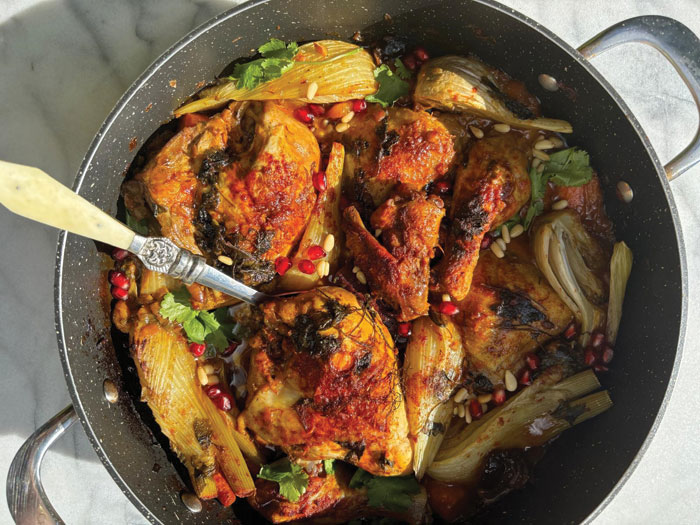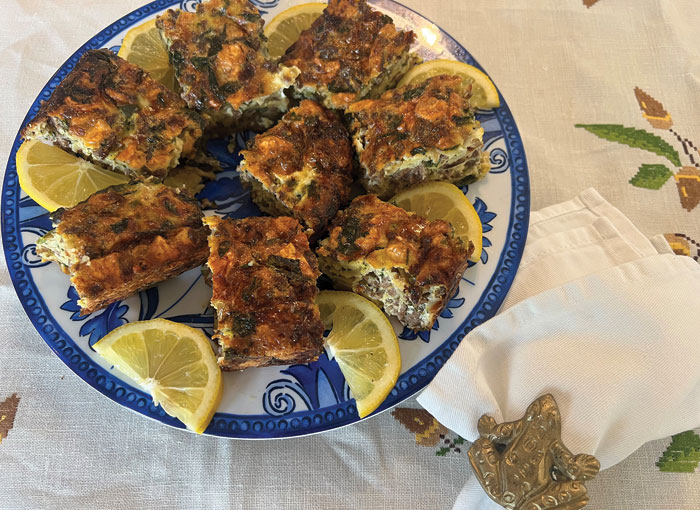 Chicken Tagine
Chicken Tagine There is no time in the Jewish calendar that proves the unity of the Jewish people more than Passover. Every household undergoes a spring cleaning. Everyone has the opportunity to attend a seder, be they in Beverlywood or Bondi Beach, Jerusalem or New Jersey, Marrakesh or Mumbai. It might be a lavish Passover program or a Chabad seder, but every Jew will be reading from the same Haggadah and making the same blessings.
There is nothing that tells the story of the Jewish people better than Passover. The hardships of slavery, the redemption of the people, the giving of the Torah and our birth as a Nation.
There is nothing that tells the story of our Exile and Diaspora better than the differences in the foods that Ashkenazim and Sephardim eat at Passover.
The seder plate, called “ke’arah,” features the symbolic foods around which the seder is conducted. The matzah represents the bread of affliction and its lack of leaven (chametz) the haste with which we left Egypt. Most families eat those mass manufactured boxes of Manischewitz or Yehuda matzah, but there is also matzah sh’mura, a hand-baked round matzah that is extra-thin and extra cardboard in flavor. The Syrian and Iraqi Jews traditionally ate a hand-baked matzah that was thin and soft.
The “Zero’ah” is a lamb shank or chicken bone that represents the strong hand of the Almighty that defeated the mighty Pharoah and took us out of Egypt.
The “Beizah” is a hard-boiled egg that symbolizes the “chagigah korban,” the pre-holiday sacrifice that was given in the days of the Holy Temple.
“Maror” are the bitter herbs. Sephardim eat Romaine lettuce because the leaves are green and pleasant, but the stem is hard and bitter: just as the work in Egypt began voluntarily and the Jews received recompense, but it then devolved into slavery. For Ashkenazi Jews, the bitter herbs are represented by horseradish because greens were less available in Europe. Nowadays, Ashkenazi Jews do use romaine lettuce for chazeret, an additional bitter herb alongside the Haroset and matzah in the Hillel sandwich.
“Karpas” is the vegetable that is dipped into the salty water that represents the salty tears of the slaves. For Ashkenazim, the karpas is either a boiled potato or parsley. For Sephardim, it’s celery dipped in vinegar (Rachel‘s family) or lemon juice (Sharon‘s family).
“Haroset” represents the mortar used in building the pyramids. For Ashkenazim it’s a mixture of grated apples, nuts and wine. But for the Sephardim there are numerous recipes for haroset, all involving dates and nuts. For Neil’s Rhodesli family, it’s a paste made with cooked apples and dates, toasted ground almonds and wine. Rachel still makes her mother’s Moroccan truffle recipe of mashed dates, ground walnuts, raisins and sweet wine. And for the Iraqi Jews it’s Silan (date honey) mixed with ground walnuts.
—Rachel and Sharon
The Passover meal is always a big deal for my family and I make a lot of food knowing there’ll be yummy leftovers. Instead of gefilte fish, I serve my mother’s Moroccan fish balls cooked in a deep red tomato sauce. I make a lamb tagine spiced with cinnamon, cumin, saffron and turmeric and sweetened with raisins, apricots and prunes. I fry up tons of keftes di prasa, leek patties made with a mixture of cooked leeks, mashed potatoes, matzah meal and eggs. I have to make a ton because they are my kids absolute favorite.
When I married Neil, my mother told me that if it’s the tradition of my husband’s family to eat rice on Passover, I should also eat rice. Eventually, my parents also joined the club and began eating rice. But I never serve rice at my seder meal.
Perhaps you’ve heard of mina, also known as megina, found in the Sephardic cuisines of the Mediterranean, from Turkey and Greece to Egypt and Syria. Mina is a layered matzah pie, kind of like a modern-day lasagna. Squares of matzah are softened with water until pliable, then placed in a baking dish in alternate layers with savory fillings, then baked. There are minas made with ground beef, lamb, spinach, or eggplant or cheese. But for Neil’s family their mina is a quajado de carne. No seder meal is complete without this delicious pie made with a mixture of ground beef, sautéed onions, parsley, eggs and soaked pieces of matzah that is then baked.
Serve this as a main dish or as an appetizer.
Like my husband, you’ll enjoy eating the leftovers for lunch all week long.
—Rachel
For me, this Passover will be special because my immediate family unit will be reunited after eight long months apart. Alexandra will be home from Israel and Gabriella from New York. This Passover will be difficult because we’ll miss my father and our hearts will ache for the bereaved families in Israel.
Nothing tells the story of the Jewish people more than our unity and love for our brethren wherever they are in the world.
Nothing tells the story of the Jewish people more than our unity and love for our brethren wherever they are in the world.
At a time when we need comfort more than ever, this Passover I’ll be making homemade matzah ball soup, shepherd’s pie, okra and butternut squash stew with rice, ajja (my grandmothers Iraqi-style herb frittata) and a fabulous Moroccan inspired tagine chicken. This tagine recipe is perfect for making ahead and reheating — the chicken bones will melt a little more and the deep, sweet caramelized flavors will intensify. This recipe calls for prunes and apricots, but dates and raisins will also work. I used fennel, carrots and parsnip, but you can also add potatoes. I will serve it with a side of rice but you can serve it with quinoa.
We hope your Passover menu tells a happy story and creates beautiful memories for your friends and family.
—Sharon
Chicken Tagine
Marinade:
½ cup olive oil
2 tsp salt
2 Tbsp sweet paprika
2 Tbsp turmeric
1 Tbsp grated fresh ginger, grated
8 garlic cloves, finely chopped
1 cup chopped cilantro
Tagine:
1 whole chicken, cut in pieces
¼ cup olive oil
1 large onion, finely chopped
½ cup whole pitted prunes
½ cup whole dried apricots
1 cinnamon stick
1 Tbsp turmeric
1 Tbsp cinnamon powder
1 big pinch saffron
2 fennel bulbs, cut into 4 wedges
4 medium carrots, chopped
1 parsnip, chopped
½ cup red wine
1/2 cup water
1 bunch cilantro
Cilantro, pomegranate arils and pine nuts, for garnish
In a large bowl, combine ½ cup oil, salt, paprika, turmeric, ginger, garlic and cilantro.
Add the chicken and coat all sides in marinade. Let sit for 1/2 hour.
In a tagine or Dutch oven, warm ¼ cup oil over medium heat.
Sauté onion for 5 minutes, then add the prunes, apricots, turmeric and cinnamon stick.
Add the carrots and fennel, then add the chicken in the center of the pot.
Sprinkle the cinnamon and saffron over the chicken and sauté for 10 minutes
Add the wine and water, then cover pot. Simmer over low heat for two hours.
Top with cilantro, pomegranate arils and pine nuts just before serving.

Quajado de Carne
1 large onion, finely chopped
2 tablespoons extra virgin olive oil
2 pounds ground beef
1 cup farfel (or crushed matzah)
1 tablespoon salt
1 teaspoon white pepper
1 cup chopped Italian parsley
10 eggs (set aside 2)
Preheat oven to 400°F.
Place the matzah farfel in a small bowl, then pour warm water over it.
Warm olive oil in a pan over medium heat, then sauté the onion until it starts to soften. Add the ground beef and continue to sauté until the meat is fully browned. Set aside to cool.
In a large bowl, beat 8 eggs with a fork. Add the salt and pepper and parsley.
Drain all the liquid out of the matzah farfel, then add to the egg mixture.
Stir the ingredients together to combine well.
Pour mixture into a well oiled 9×13 inch oven-safe dish.
Beat the two reserved eggs and spread on top of the meat mixture.
Bake for 30-40 minutes or until golden brown.
Can be frozen after cooking.
Sharon Gomperts and Rachel Emquies Sheff have been friends since high school. The Sephardic Spice Girls project has grown from their collaboration on events for the Sephardic Educational Center in Jerusalem. Follow them on Instagram @sephardicspicegirls and on Facebook at Sephardic Spice SEC Food. Website sephardicspicegirls.com/full-recipes.























 More news and opinions than at a Shabbat dinner, right in your inbox.
More news and opinions than at a Shabbat dinner, right in your inbox.